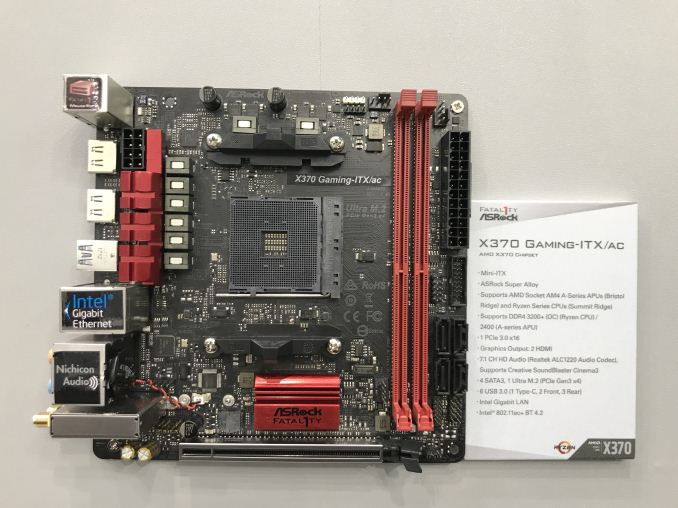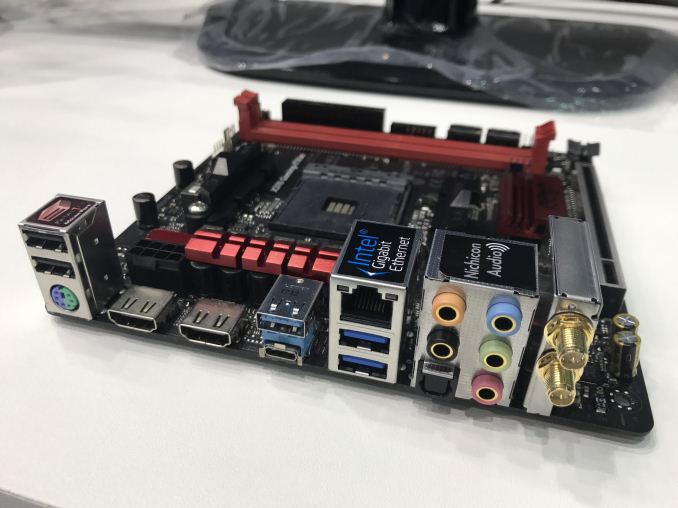ASRock Gives AMD Ryzen Mini-ITX Treatment, Launches X370 Gaming ITX/ac
by Anton Shilov on May 31, 2017 1:00 PM EST- Posted in
- Motherboards
- AMD
- ASRock
- Mini ITX
- Trade Shows
- AM4
- Ryzen
- X370
- Computex 2017

ASRock has introduced a miniature motherboard for AMD Ryzen microprocessors, one of a few such motherboards in the industry. Despite being very small, the X370 Gaming ITX/ac offers everything that a fairly powerful gaming system might require and its price is not too high.
The ASRock X370 Gaming ITX/ac is based on the AMD X370 chipset and supports all currently available processors in the AM4 form-factor, including A-series APUs as well as all Ryzen CPUs. The motherboard has a digital eight-phase VRM for the CPU designed to guarantee clean power supply (stability, overclocking potential, etc.). According to ASRock, the mainboard can handle DDR4-3200+ memory (assuming that particular modules work well with AMD Ryzen processors). The new platform has two DIMM slots in total.
Like many other motherboards in the Mini-ITX form-factor, the X370 Gaming ITX/ac has one PCIe 3.0 x16 slot, one M.2 slot for PCIe 3.0 x4 or SATA SSDs, as well as four SATA ports. Meanwhile in a light bit of irony, the mainboard uses GbE and 802.11ac Wi-Fi controllers from Intel. As for other I/O, everything seems to be pretty standard here: the motherboard has two HDMI outputs, five USB 2.0 ports, six USB 3.0 headers (including one Type-C) as well as a 7.1-channel audio powered by Realtek ALC1220 codec with Creative’s Sound Blaster Cinema 3 enhancing software.
| ASRock's Mini-ITX Motherboard for AMD Ryzen | ||
| X370 Gaming ITX/ac | ||
| CPU Support | CPUs in AM4 form-factor AMD Ryzen and AMD A-series APUs |
|
| Graphics | PCIe 3.0 x16, or integrated in case of APUs | |
| Chipset | AMD X370 | |
| Memory | Two DDR4 DIMM slots | |
| Ethernet | 2 × Intel GbE controllers | |
| Display Outputs | 2 × HDMI for APUs | |
| Storage | 4 × SATA 6 Gbps 1 × M.2 (PCIe 3.0 x4 or SATA) |
|
| Audio | Realtek ALC1220 7.1 channel audio Creative’s Sound Blaster Cinema 3 enhancing software |
|
| USB | 5 × USB 3.0 Type-A 1 × USB 3.0 Type-C 5 × USB 2.0 |
|
| Other I/O | 802.11ac Wi-Fi + Bluetooth 4.2 | |
| Form-Factor | Mini-ITX | |
| MSRP | $150 ~ $160 | |
At present, the ASRock X370 Gaming ITX/ac has only one direct rival, the Biostar Racing X370GTN introduced earlier this year. The Racing X370GTN does not have Wi-Fi support, but it has two USB 3.1 Gen 2 (10 Gbps) headers, including one Type-C. Meanwhile, the X370 Gaming ITX/ac seems to have a more advanced VRM for those looking forward overclocking capabilities.
The ASRock X370 Gaming ITX/ac will be available in the coming weeks for $150 – $160, according to the manufacturer. Keep in mind that since there are only two AMD X370-based Mini-ITX motherboards announced so far and small form-factor systems are gaining traction, demand for the X370 Gaming ITX/ac will be very high. That said, don't be surprised if there's some overpricing from select retailers.
Related Reading:
Source: ASRock













40 Comments
View All Comments
thatactuallyguy - Thursday, June 1, 2017 - link
I'm not sure Anandtech's spec listing is quite correct. For one, they list 2 ethernet controllers when there's clearly only one port. Then there's the fact that most of the USB ports are the standard royal blue of USB 3.1G1, while the USB-C port and the A port above it are the light blue usually associated with USB 3.1G2. I get the feeling final specs are 1 ethernet controller, 1 USB-C 3.1Gen2, and 1 USB-A 3.1G2.Alexvrb - Wednesday, May 31, 2017 - link
I'm looking forward to cheaper ITX boards built on the lower-end A300 chipsets, along with APUs to match. For the current Ryzen CPUs (which require a dGPU) I think mATX is sufficiently compact. Which is a possibility for my next rig, mATX X370 build. But for ITX I'd rather see budget boards and APUs so I can build inexpensive and compact TV-friendly builds.I'm not saying higher-end ITX boards don't have a market, but I personally am not interested in an X370 board smaller than mATX.
Roland00Address - Wednesday, May 31, 2017 - link
I am going to get so much hate for saying this for I am effectively talking out loud, but what is the point of mini itx at 170mm height and width vs micro atx 244 mm height and width aka 6.6 inches by 6.6 inches vs 9.6 inches by 9.6 inches. IF (and this IF is the reason for the post) you are going to end up with a single slot graphic card, or a single slot graphic card but the height not of the motherboard but instead the case is big enough that you can put a double slot graphic card in there.Sure there are many workloads that are cpu only and no gpu. But how many people build their own PC if this is their goal and a single slot GPU is enough.
Yet if a single slot graphic card is enough why not just get an APU, since APUs compete with what you are going to get with a 75w single slot gpu?
What I am saying is I see a VERY SMALL market for this, people who want AMD Ryzen with 6 or 8 CPU cores and hyperthreading yet at the same time care little about graphic power and think the 4 cores APUs of AMD Raven Ridge is not worth the wait and not worth the limits of 4 cores and hyperthreading when you can instead have 6 or 8.
------
I am all for small form factor pcs I just can't foresee the market for this being very large. That said most of my complaints is not really about this motherboard in general but instead the dimensions of the itx motherboard and the lack of alternate solutions for gpus than the standard form factor without doing something like a riser cable or such. How hard would it be for the motherboard company to embed an integrated graphics with a standard low end AMD GPU on the motherboard. Wait I know the answer to this and the answer is even less worth it than having an ITX motherboard without integrated graphics. We simply do not do that anymore now that graphics is on the APU or on a dedicated separate card, and if you are going single slot cards you are just putting in a crappy effectively an APU graphics. If die size was the only concern we could do a separate cpu die and a small integrated graphics die like they did with clarkdale but they do not do that anymore for the volume is just not there.
Well this is not really a problem if you use an riser cable and you have a case designed for a riser cable but how popular are those things really.
I love itx for small form factor office PCs with integrated graphics but if you are going to do a 6 core / 12 thread behemoth just spend an extra 3 inches of height, it is worth it. That or spend 30 dollars for a riser cable and get a case designed around putting the GPU in a different angle than perpendicular with the itx motherboard. There is just a limit of how much you can cram into a case with the standard atx form factor parts instead of us moving to some different style form factor.
Now that thunderbolt 3 is royalty free and open to everyone (as of May 2017 aka this month, Intel announced the change for they they are embedding it into their future cpus they are now allowing anyone to make thunderbolt 3 to promote the thunderbolt 3 being the new usb.) Note the physical die size of the old 2015 thunderbolt 3 controller is 10 mm by 10 mm aka it is barely bigger than a usb c port I will not be surprised that in the future we will see AMD and other motherboard people doing an off the shelf thunderbolt chip since the old cost for the thunderbolt chip was $6.45 for a single thunderbolt port and $8.00 for a two thundersports and this price is before volume discounts and now that it is royalty free we may see motherboard makers include it on their $150 motherboards just like they include wifi chips and so on with some other chip maker making the thunderbolt port not that is a commodity. Aka we may finally move to phones docking stations and laptop docking stations using wires, but also things like 8 cpu cores 16 threads in a small form factor with a connection to a docking station that gives you graphics card, power, usb, and so on.
Egg - Wednesday, May 31, 2017 - link
I can't figure out what you're trying to say.You can use double slot GPUs with mini-ITX motherboards.
Alistair - Thursday, June 1, 2017 - link
too much typing not enough thinking...Manch - Thursday, June 1, 2017 - link
Put down the Dew, Red Bull, Monster, or whatever you're drinking.Back away from the KB.
Drink some water.
Take a nap.
Wake up fresh.
Collect your thoughts.
Try again.
This caffeinated rant is unreadable.
TheinsanegamerN - Thursday, June 1, 2017 - link
this whole comment is full of wat.thatactuallyguy - Thursday, June 1, 2017 - link
Well firstly, in trying to downplay the size difference you actually highlighted the extent of it, ITX is nearly 30% smaller than MicroATX, that's no small thing [pun intended].Secondly, graphics support is case limited not motherboard limited, unless you consider the tiny tiny percentage of SLI/Crossfire users as the only real enthusiasts out there. Most enthusiast MiniITX cases have 2 or even 3 PCI brackets for dual or triple slot cards, and are big enough to fit the majority of even 1080 Ti variants out there. Just look at the NCASE M1 or the Fractal Design Node 202 or even the DAN A4, people are building truly beastly systems in those tiny cases because they were designed from the ground up for enthusiast hardware.
MiniITX is never going to be a massive market, but that doesn't mean it isn't a worthwhile or healthy market.
TheinsanegamerN - Thursday, June 1, 2017 - link
Cant wait for reviews. That will most likely be the heart of my new replacement rig.Lukart - Thursday, June 1, 2017 - link
Thats all nice, so many requests for the ITX, how about the oc-forumla for the Ryzen?I guess they dont see AMD as overclocker :P